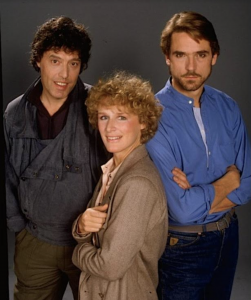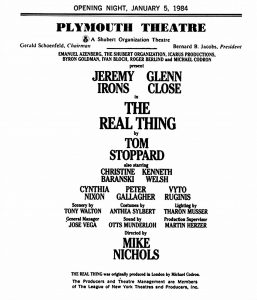For decades I tried to catch the most highly-regarded Manhattan plays, and I’m very grateful that I made the effort. We all realize that the last Broadway era for great playwriting ended between 20 or 25 years ago. It’s all musicals now, and damn the sappy tourists for making this happen.
For me the mid ’70s to mid ’80s was close to a golden stage era. Which isn’t to say it was the greatest by the measure of any Broadway-veteran perspective, but simply a time when I was living near or in Manhattan, or often flying there from Los Angeles. Things were happening and I knew I had to get what I could.
It was a time in which certain well-reviewed plays (and one glorious musical, Sunday in the Park With George) seemed to speak directly to me and my experience…written by the youngish lions of that era (David Mamet, Simon Gray, Harold Pinter, Tom Stoppard, Peter Shaffer) and focused on anxious, unsatisfied white guys whose situations seemed to echo my own…taunted by various urban anxieties, ambitions…by aloneness, sex/love, existential voids, “who am I?”, “what’s it all about?” and “will my life always seem this much of an uphill thing?”
It almost makes me weep to reflect on that period, which for me began in ’76 and started to wind down in ’85. (I lived in Manhattan for a bit more than five years — ‘early ’78 to ‘mid ’83.) Film-wise and quite sadly for many of us, the last third of the ’70s marked the beginning of the end of the “Easy Riders, Raging Bulls” period, and the early ’80s would became known as an era in which “the bottom [had] fallen out of badness in movies,” to borrow from Andrew Sarris.

But the quality of the plays seemed wonderful; ditto the culture (mostly pre-AIDS) itself. Life was hard, of course (my finances were mostly a shambles until ’87) and the wrong people were in power and writers were stuck with typewriters and white-out, but compared to today it almost seems as if I was living a kind of half-charmed life. I could live and work and run around (my batting average was around .400, give or take**) and write without fear of wokester death squads, for one thing.
I wouldn’t say that my future seemed especially rosey or brilliant back then, but it certainly lay ahead. You don’t know what you’ve got ’til it’s gone.
The Reagan-era play that lifted me up and melted me down like none before or since was Tom Stoppard‘s The Real Thing (’84). Sappy as this sounds, it made me swoon. Okay, not “swoon” but it struck some kind of deep, profound chord. Partly because I saw it at a time when I believed that the right relationship with the right woman could really make a difference. That was then and this is now, but I was in the tank for this stuff in ’84. The play used the Monkees’ “I’m A Believer” as mood music, and I pretty much was one at the time.
I’m speaking of the original B’way production, of course, directed by Mike Nichols and costarring Jeremy Irons and Glenn Close. My admiration for Irons’ performance as Henry, a witty London playwright who resembled Stoppard in various ways, was boundless. Close, whom I was just getting to know back then, was truly magnificent as Annie. N.Y. Times critic Frank Rich called it “not only Mr. Stoppard’s most moving play, but also the most bracing play that anyone has written about love and marriage in years.”
(I went to see the 2000 B’way revival and was bitterly disappointed by Stephen Dillane‘s uncharismatic lead performance, which wasn’t even close to what Irons had brought.)
I was also floored that same year by James Lapine and Stephen Sondheim‘s Sunday in the Park With George, which opened at the Booth theatre on 5.2.84. It was one of the few B’way musicals that really reached inside, and it still makes me choke up when I watch it on YouTube.
I’m just going to list some of the plays that really hit the sweet spot between ’76 and ’85…I’m bypassing a few but here we go regardless:
Peter Shaffer‘s Equus, which I saw in London in the early summer of ’76. The great Colin Blakely was magnificent in the lead role of psychiatrist Martin Dysart (and better, I have to say, than Richard Burton was in the Sidney Lumet film version). I saw Anthony Perkins play the role in a B’way production of Equus in ’77, and I’m sorry to say that he underwhelmed.
A Broadway production of David Mamet‘s American Buffalo in early ’77. Directed by Ulu Grosbard with Robert Duvall, Kenneth McMillan and John Savage costarring. Four years later I saw it again (twice) at the Circle in the Square with Al Pacino as Teach. Pacino wasn’t a robot — he played certain lines and scenes a bit differently at times…experimentally, if you will. I was in heaven.
That same year I was wowed by a B’way production of Simon Gray‘s Otherwise Engaged, which starred Tom Courtenay as the lead character, Simon, a London-based publisher. I saw it a second time with Dick Cavett in the lead role — I didn’t expect his performance to compete with Courtenay’s and it didn’t, but Cavett was decent enough. I’m very sorry I never saw the original London production with Alan Bates as Simon.
An early 1980 Broadway presentation of Pinter’s Betrayal with Roy Scheider, Blythe Danner and Raul Julia in the lead roles…God! I adored this production through and through, and I was particularly pleased with Scheider (who delivered a better-than-decent British accent.) Danner and Julia were also exceptional. I adore David Jones’ 1983 film version although Jeremy Irons and Ben Kingsley‘s performances outshone Patricia Hodge‘s, who seemed miscast to me.
In late ’80 I caught a London production of Ronald Harwood‘s The Dresser. I’m not recalling what time of year but it was presented at the Queen’s Theatre with the always robust Freddie Jones as “Sir” and Tom Courtenay as Norman. I had an awful seat (last-minute purchase) but it still seemed better than Peter Yates’ 1983 film version.
I caught an early ’81 (spring?) performance of Shaffer’s Amadeus at the Broadhurst Theatre, with the magnificent Ian McKellen as Salieri and Peter Firth as Mozart. A much, much better thing than the 1984 Milos Forman film version.
That same year I was mesmerized by Chris Walken‘s portrayal of Trigorin in a Public Theatre presentation of The Seagull.
I caught an early ’83 presentation of David Hare‘s ascerbic Plenty at B’way’s Plymouth theatre. Kate Nelligan was alive and blazing in the lead role. Meryl Streep nailed it also in Fred Schepisi‘s 1985 film version.
Sometime around 3.25.84 I attended a Broadway pre-opening performance of the original Gregory Mosher-directed play with all the big-gun critics (Frank Rich, etc.) in the orchestra. Joe Mantegna‘s Tony Award-winning performance as Ricky Roma ruled — a performance as seminal and historic as Humphrey Bogart‘s Duke Mantee in the B’way stage version of The Petrified Forest. Not to mention Mike Nussbaum, Robert Prosky (a brilliant Shelley Levine), Lane Smith, James Tolkan, Jack Wallace and J.T. Walsh.

** I didn’t look upon romantic relationships in terms of hits or strike-outs, but that’s what they always boil down to at first. I never regarded myself as a hound. I regarded every intriguing romantic possibility with absolute sincerity. My heart lit up each and every time I connected with someone. The truth is that I was dumped or brushed off time and again, largely because I was poor and constantly grappling with writing issues and deadlines and whatnot. Most women tend to prefer guys who are at least somewhat secure and steady, and that certainly wasn’t me back then. So that .400 batting average, in the midst of all that rejection, was at least a modest comfort.
